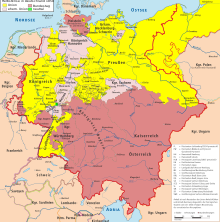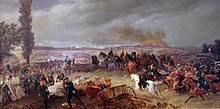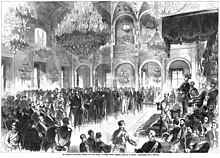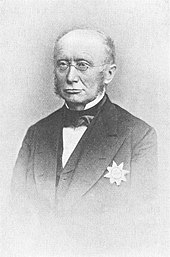North German Confederation
The North German Confederation was a federal state. It united all German states north of the Main River under Prussian leadership. It was the historical precursor of the Prussian-dominated solution to the German question, which was realized with the founding of the German Empire, to the exclusion of Austria. Founded as a military alliance in August 1866, the League acquired the quality of a state through a constitution of July 1, 1867.
The federal constitution largely corresponded to the constitution of the Empire of 1871: legislation was the responsibility of an Imperial Diet, elected by the male people, and a Federal Council, representing the governments of the member states (mostly duchies). To pass laws, both had to agree. The head of the Confederation was the Prussian king as holder of the Federal Presidency. The responsible minister was the Federal Chancellor. The conservative Prussian Prime Minister Otto von Bismarck was the first and only chancellor in the few years of the North German Confederation.
With its numerous modernising laws on the economy, trade, infrastructure and the legal system (including the forerunner of today's penal code), the Reichstag essentially prepared for later German unity. Some of the laws were already effective in the southern German states before 1871 via the German Customs Union. However, parliamentary control over the military budget was still limited, although military expenditure accounted for 95 percent of the total budget.
The hope that the southern German states of Baden, Bavaria, Württemberg and Hesse-Darmstadt would soon be able to join the Confederation was not fulfilled. In those states there was great resistance to Protestant Prussia or to the Bund with its liberal economic and social policies. This became apparent in the election to the Customs Parliament in 1868; however, this cooperation of North German and South German deputies in the Zollverein contributed to the economic unity of Germany.
After a diplomatic defeat in the Spanish throne succession dispute, France started the war against Germany in July 1870. It wanted to prevent a further strengthening of Prussia and a German unification under its leadership. However, the southern German states of Baden, Bavaria and Württemberg had formed defensive alliances with Prussia after their defeat in the German War of 1866. Therefore, and due to their better organization, the German armies were able to quickly carry the war into France.
Through the November treaties of 1870, the southern German states joined the North German Confederation. With the so-called founding of the Reich and the entry into force of the new constitution on 1 January 1871, the Confederation was absorbed into the German Empire.
Origin
→ Main article: Foundation of the North German Confederation
Prehistory until 1866
Since the 18th century, there had been another power in Germany besides the Austrian Habsburg monarchy that claimed a leading role: Prussia, which had risen to the status of a kingdom in 1701 and had, among other things, conquered from Austria Silesia, which was rich in mineral resources. The relationship between these two great central European powers was known as German dualism, which was characterized by rivalry, but often also by cooperation to the disadvantage of third parties.
The expansion of the Confederation or even the transition to a federal state, which was desired by many Germans, was prevented by Austria and Prussia: The Empire of Austria saw a German federal state as a threat to its existence because of its own nationality conflicts, and Prussia did not want any further development of the German Confederation as long as Austria alone was considered a "presidential power". As early as 1849, Prussia endeavoured with the "Erfurt Union" first to create a Little Germany without Austria and Bohemia, without the Habsburgs and without the German Confederation, then at least a North German federal state under Prussian leadership. However, Prussia had to abandon this attempt in the autumn crisis of 1850 due to pressure from Austria, the Mittelstaaten and Russia.
Subsequently, the Great Powers again cooperated, but this was much more overshadowed by rivalry than in the years 1815-1848. After 1859, both Great Powers made unsuccessful proposals for federal reform. A division of Germany into North and South was also part of this. Although they again acted together against the German states in the war against Denmark around 1864, they were soon at odds over the Schleswig-Holstein question and settled this dispute militarily as well.
Prussian Prime Minister Otto von Bismarck made several efforts to reach a settlement with Austria, but in the end he steered Prussia towards confrontation with Austria and, if necessary, the other states. The Austrian Emperor Franz Joseph I, in turn, was unimpressed, considering Bismarck's position in Prussia to be weak and estimating his own military power to be insurmountable. Thus, on June 14, 1866, Austria obtained a federal resolution from the Bundestag on the mobilization of the federal army against Prussia.
German war and consequences of war
In the German War of 1866, however, Prussia and its allies were victorious against Austria and its allies (the kingdoms of Bavaria, Württemberg, Saxony and Hanover, the grand duchies of Baden and Hesse, the Electorate of Hesse and other small states). In the preliminary peace with Austria (July 26) Prussia enforced the reorganization of the relations in the north of Germany up to the Main line. It is here that the term North German Confederation first appears. Prussia had already agreed this arrangement with the French Emperor Napoleon III beforehand.
On October 1, 1866, Prussia annexed four of its wartime enemies north of the Main: Hanover, Kurhessen, Nassau, and Frankfurt. The remaining states were allowed to retain their territories with almost no changes. The annexations increased Prussia's population from about 19 million to nearly 24 million.
Three other war opponents north of the Main, namely Saxony, Saxe-Meiningen and Reuß of the older line, were obliged in the peace treaties to join the North German Confederation. The Grand Duchy of Hesse had to join the Confederation with its province of Upper Hesse as well as the municipalities of Kastel and Kostheim on the right bank of the Rhine (Rheinhessen), all of which lay north of the Main.
August Treaties and the Constituent Diet
→ Main articles: August Treaties and Constituent Diet
On August 18, 1866, Prussia concluded a dual-purpose alliance treaty with 15 northern and central German states, which eventually became known as the "August Alliance". Later, other states such as the two Mecklenburgs (Mecklenburg-Schwerin and Mecklenburg-Strelitz) joined the treaty (hence "August Treaties"). On the one hand, they formed a defensive alliance that was limited to one year. On the other hand, the August alliance was a preliminary treaty for the founding of a federal state.
The basis was to be the federal reform plan of June 10, 1866, which Prussia had sent to the other German states at that time. However, this plan was still very general and at that time still included Bavaria and the rest of Little Germany. Thus, the August Alliance did not yet have an actual draft constitution, unlike the Epiphany Alliance of 1849 for the Erfurt Union.
The August alliance also agreed on the election of a joint parliament. This would represent the North German people in the constitutional agreement. The basis for the election were laws of the individual states. These laws adopted, by agreement, the Frankfurt Imperial Election Law of 1849 almost verbatim. The North German Constituent Diet was elected on February 12, 1867, and was opened in Berlin on February 24 by King William I of Prussia. After long negotiations, the Reichstag, which met in the Hardenberg Palace in Berlin, adopted the amended draft constitution as early as 16 April and had its final formal session the following day.

Germany in Autumn 1850: States of the Erfurt Union (yellow) and those of the Truncated Union (dark red)

Georg Bleibtreu: Battle of Königgrätz, painting from 1868. This battle in Bohemia was the decisive Prussian victory against Austria.

Ceremonial Opening of the North German Constituent Diet in the Royal Palace, Berlin on 24 February 1867
Political system
Federal Constitution
→ Main article: Constitution of the North German Confederation
The Prussian Landtag and the constituent Reichstag were dominated by a National Liberal-Freiconservative majority. The National Liberals in particular originally wanted the most radical solution possible: Germany should become a unitary state under Prussian leadership. For example, the other states of northern Germany should simply have joined Prussia. Prussia, with its military power, could have forced them to do so. Bismarck, on the other hand, sought a federal solution. On the one hand, he did not want to deter the southern German states and their princes from also joining later. On the other hand, he was concerned with his own mediating role and thus with his position of power between the king, the Diet and the allied states.
As a result of these considerations, Bismarck strove for a North German federal constitution that concealed its unitary features and also the power of the Prussian king. As far as possible, the new federation was to outwardly resemble a confederation of states. For example, the military power in the constitution was subordinated to a federal field commander. This designation dated from the time of the German Confederation; at that time the Prussian king had attempted to become the permanent federal field commander of the federal army, or at least of the northern German federal forces. The constitution, however, made it clear elsewhere that the Bundesfeldherr was none other than the Prussian king.
Privy Councillor Maximilian Duncker had prepared a first draft of the constitution on behalf of Bismarck. After several revisions by envoys and ministry officials, Bismarck himself put his own hand to it, and finally, on December 15, 1866, a Prussian draft was presented to the plenipotentiaries of the governments. Some of the plenipotentiaries had considerable reservations, sometimes wishing for more federalism, sometimes for a stronger unitary state. Bismarck adopted 18 amendments that did not touch the basic structure, and the plenipotentiaries agreed on February 7, 1867. This draft was then a joint constitutional offer of the allied governments.
The draft was sent to the constituent Reichstag on 4 March. In its deliberations, the constituent Reichstag closely coordinated with the plenipotentiaries of the individual states. In this way, compromises were reached on which both sides could agree. On 16 April 1867, not only did a majority of the Reichstag pass the amended draft, but it was also immediately approved by the plenipotentiaries. The individual states then had their state parliaments vote and published the federal constitution. This process lasted until 27 June. On 1 July, the constitution could enter into force as agreed. The constitution of the North German Confederation is, apart from some designations and details, already identical with the constitution of the German Empire of 16 April 1871, which was applied until 1918.
In the heated deliberations of the Reichstag, Bismarck's draft had been considerably amended. The Reichstag strengthened the federal competence and its own position. The national liberal deputy Rudolf von Bennigsen succeeded in pushing through the so-called Lex Bennigsen: The Federal Chancellor had to countersign the orders of the Federal Presidium (the Prussian king) to make them effective, and thereby assumed (ministerial) responsibility. He thus became an independent federal organ. Bismarck himself originally wanted to see the Federal Chancellor only as an executive official; now he was the key figure in the complicated decision-making structure (Michael Stürmer).
Federal bodies
The King of Prussia was entitled to the presidency of the Confederation, a title such as "Emperor" was dispensed with. Not in name, but in fact he was the head of the Confederation. He appointed a Federal Chancellor, who countersigned the acts of the Presidium. Thus, the Chancellor was the only responsible minister, that is, the federal government (executive) in one person. The responsibility is not to be understood parliamentary, but political.
The Federal Chancellor was given a supreme federal authority, the Federal Chancellery (it was later renamed the Reich Chancellery and should not be confused with the Reich Chancellery of 1878), to support his work. During the period of the North German Confederation, only one other supreme federal authority was established, the Foreign Office, which had been taken over from Prussia. The head of the Federal Chancellery and the head of the Foreign Office were not colleagues of the Chancellor, but were subordinate to him as officials authorized to issue directives. Bismarck resisted the efforts of the Reichstag to establish regular federal ministries. In practice, Bismarck often used the assistance of the state ministries, especially the Prussian ministries, simply because he lacked his own personnel at the federal level.
The constituent states sent plenipotentiaries to the Federal Council. This representation of the constituent states was a federal body that had executive, legislative, and judicial powers. The federal government did not have a constitutional court, but the Federal Council decided certain disputes between and within the constituent states.
The Bundesrat, together with the Reichstag, exercised the right to legislate, including the approval of the budget. Diets, i.e. parliamentary allowances, were prohibited by the constitution. In the electoral law of the Federation, universal and equal male suffrage was enshrined. Every North German had one vote for a candidate in the constituency in which he lived. Each constituency sent one representative to the North German Reichstag. In May 1869 the Federal Electoral Law came into being, which basically retained the provisions of the individual state laws of 1866.
Chairman of the Bundesrat was the Federal Chancellor. In itself, he had neither a seat nor a vote in it. But Chancellor Bismarck was at the same time Prussian Prime Minister. In this way he had the greatest influence on the Prussian votes in the Bundesrat and thus on the entire Bundesrat. This combination of offices was not provided for in the constitution, but it was maintained almost throughout the period of the North German Confederation and the German Empire.
Elections and parties
The Prussian parliamentary elections of July 13, 1866 (the primary election took place before the announcement of victory from Königgrätz arrived) amounted to a landslide. The Liberals lost about a hundred seats, while the Conservatives gained as many. Prussian liberalism was thus less entrenched in the electorate than had been thought. Bismarck, however, tried to reach a balance with Austria externally, and with the Liberals internally, in order to gain greater room for manoeuvre. Shortly after the war he announced the so-called Indemnity Bill: He asked the Landtag to retroactively approve his unconstitutional measures of the conflict years.
Bismarck's attitude led to a split in both the liberal Progressive Party and the Conservatives. The National Liberal Party split from the former in 1867, and the Free Conservative Party from the conservatives. Both became in the long run Bismarck's pillars in parliament. The more left-wing Liberals, on the other hand, were permanently resentful of Bismarck's conflict period with its breaches of the constitution, and the more right-wing Conservatives were opposed to concessions to Liberals.
The Catholic deputies were rather weakly represented in the Reichstag of the North German Confederation. Among other things, they worked together in the Federal-Constitutional Association. Even before the founding of the German Reich, they united between June and December 1870 to form the Centre Party, which wanted to defend the rights of the Catholic minority and the rule of law in general.
The Saxon People's Party, an anti-Prussian alliance of radical democrats and socialists, was able to send two deputies to the (constituent) Reichstag as early as February 1867, including August Bebel. Alongside his more liberal colleague, Bebel was the first Marxist in a German parliament. In the ordinary Reichstag elected in August, the SVP provided three deputies, the General German Workers' Association two. The separation of bourgeois radical democrats and socialists, one of the deepest caesuras in German party history, led to the founding of the Social Democratic Workers' Party in Eisenach in 1869.
Thus, the parties that would later shape the Empire already existed in the Reichstag of the North German Confederation: the two liberal and the two conservative parties, the Catholic Centre Party and the Social Democrats.

Ludwig Windthorst, the former Minister of Justice of the Kingdom of Hanover, joined the Federal Constitutional Union in the Reichstag in 1867, which united the anti-Prussians. Later he became the most distinguished parliamentarian of the Centre.

"The Reichstag is haunted": caricature on Chancellor Otto von Bismarck rejecting the establishment of federal ministries.

Constitutional diagram for the North German Confederation, with the development into the German Empire
Questions and Answers
Q: What was the North German Confederation?
A: The North German Confederation was a military alliance of 22 states in northern Germany, which later became a federal state.
Q: What preceded the North German Confederation?
A: The North German Confederation was preceded by a Zollverein, which was a customs union that allowed free trade among most German states.
Q: When did the North German Constitution come into effect?
A: The North German Constitution came into effect on July 1st 1867.
Q: What led to the Austro-Prussian War of 1866?
A: An Austrian-Prussian rivalry that had been ongoing since the 1700s led to the Austro-Prussian War of July/August 1866. Immediate causes for this war were related to Slesvig-Holstein (which Prussia intended to annex) and a reform of the German Confederation.
Q: Who was leading Prussia during this time period?
A: Minister President Otto von Bismarck was leading Prussia during this time period, serving under King William I.
Q: When did Prussia and most north German states sign an agreement?
A: On August 18th 1866, Prussia and most north German states signed an agreement known as the August Treaty. This treaty established a military alliance and declared their intention to create a federal state.
Q: How is a federal state different from other forms of government?
A: A federal state is different from an alliance because it has its own federal government and legislation, but it is also different from a unitary state because there are still powerful states below the federal level.
Search within the encyclopedia